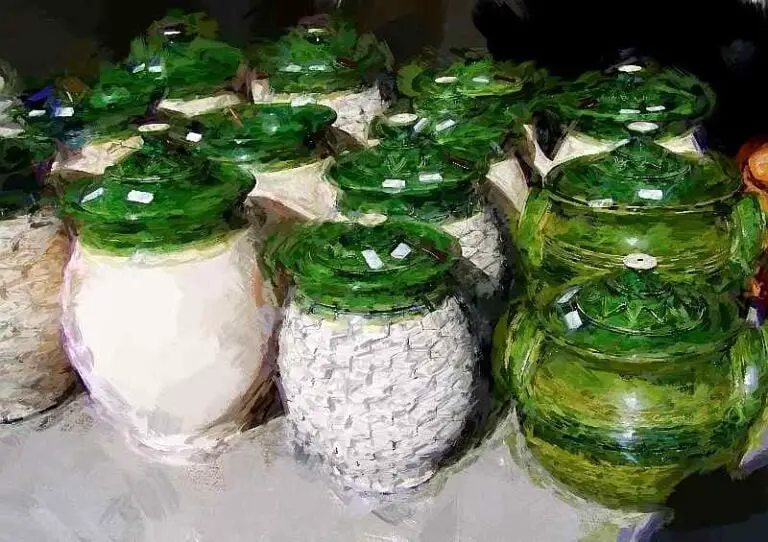Fermentation Airlock: All Your Questions Answered
What is a fermentation airlock? How do you use it? Do you need an airlock to lacto-ferment vegetables? Don’t worry, we’ve got you covered.
If you have been browsing the web searching for fermentation recipes and methods, chances are you have come across the name of a mysterious object.
The fermentation airlock.
Many revere it, others despise it and some love it so much they’d stick it in their cocktail in place of the mini umbrella.
So, you might ask…
What is an airlock for fermentation?
And, most of all, do I need one?
Here we are to shed some light.
WHAT IS AN AIRLOCK?
According to the dictionary the general airlock definition is the following:
“An airtight chamber, usually located between two regions of unequal pressure, in which air pressure can be regulated.“
Pretty self explanatory.
But how does that apply to your ferments?
Fermentation Airlock – What Does It do?
When you seal a carboy of ginger beer or watermelon wine, you do so to prevent oxygen from getting in contact with your brew.
During fermentation the magic critters release CO2 when they feed off sugars but, as you know, such CO2 must be allowed to leave the vessel to avoid explosions.
So how do we combine the need to keep oxygen away from your ferment with the absolute need to prevent a glass container from exploding?
Enter the fermentation airlock…
This little plastic device, attached to the lid of the vessel, will do exactly that: allowing CO2 to escape without letting oxygen in.
If we reaaaaallly wanted to split hairs we should say that the fermentation airlock is actually the head space inside the vessel.
And that the little plastic pipe we screw on the lid is the one way exit that makes it possible.
Based on this, remember to always leave enough headspace inside the vessel.
How To Use A Fermentation Airlock
Very easily and very simply actually.
To ferment liquids like apple cider, Blaand or wine just stick it inside the vessel bung and you are set to go.
Keep in mind that depending on the type of stopper you might also need a grommet for a more airtight result.
If you are going to lacto-ferment vegetables or fruit, fermenting with an airlock is unnecessary and often problematic; opt for a good glass jar like Bormioli Fido instead.
But if you really want to use one, there are several premade fermentation kits and lids that people seem to be really happy with.
The choice is entirely yours.
Is The Airlock Necessary?
The short answer is no.
After all our ancestors have fermented for millennia and I doubt they have ever use one.
In fact the so called airlock fermentation, the fermentation process done by using an airlocking device, is quite a novelty.
It’s true though that, in certain cases, it makes your life easier; especially when brewing beer, wine or mead.
Or any other fermented drink that contains a noticeable amount of alcohol.
What’s important is to create an airtight – anaerobic environment inside the vessel and to achieve that there are several ways that do not involve the use of a plastic airlock.
The BEST LIQUID To Put In The Airlock
Although many people put plain water inside their airlocks it’s actually not recommended to do so.
Bottled water or demineralised water are not sterile and can foster bacterial or mould growth when releasing gasses from the ferment.
Far better choices are either a high abv spirit like Vodka or, what professional brewers use, food grade glycerine.
Fermenting WITHOUT An Airlock – ARE THERE RISKS?
Ultimately, no; there are no risks involving in fermenting without an airlock IF AND WHEN things are done correctly.
In both alcoholic and lacto fermentation the main goals, among others of course, are to allow CO2 out without letting air ( oxygen ) in.
If you achieve this via special lids, an airlock, because you burp the ferment or leave the lid unscrewed it really makes zero difference to the end result.
Like I said above, fermenting airlocks can make life easier, especially to inexperienced fermies.
Airlock Types
Airlock fermentation has always been very common in beer or wine brewing but is a recent introduction to lacto fermentating vegetables and fruits.
What people apply to their jars are no other than homebrewing airlocks as there is not a device for lacto fermentation yet on the market.
There are two main airlock types.
– the S-shaped
– the three piece
The S-shaped, friendly nicknamed the bubble airlock, has a double bend in which the chosen liquid is poured and a cute little cap ( that you leave on btw )
The three piece airlock ( I am sure you already guessed it by now… ) comes in three pieces : the big chamber, the bubbler and the cap.
Self Built Airlock – DIY
There are several home made airlock types that do the job pretty well, are easy to diy and can be made for pennies.
One of the simplest ways to airlock a carboy, a narrow mouth demijohn or a bottle is done by using a balloon or a ( non lubricated ) condom.
Even a rubber glove would work, although a food grade nitrile one would be better.
Tightly place the balloon on the vessel mouth and puncture it once or twice with a needle to allow CO2 to escape.
When you are dealing with a very active ferment like mead and beer, often the best way to airlock your fermenter is by using a so-called blow-off tube.
A blow off tube is usually made with a food grade transparent plastic hose.
One end of the hose is attached to the carboy and the other is submerged in a jug full of water
This airlocking system is very efficient in letting big amounts of gas out without squirting your brew everywhere on floors and walls.
Something that would most likely happen with both the S-shaped and the 3 piece airlocks.
So, after all this reading…
Fermentation Airlock Or Not?
I can only share with you my personal opinion which is exactly that, an opinion, and people may or may not agree with it.
AIRLOCK YES
A big tick to using an airlock when brewing, meaning when we ferment using the yeast to alcohol pathway because it just makes sense to use one.
You can set and forget your brew and know that when you see no more bubbles fermentation is over and you are ready to bottle or referment.
AIRLOCK NO
A big tick on NO for the use of airlocks in lacto-fermentation of fruits and vegetables, simply because there is no need for one.
“Put an airlock on that sauerkraut ferment you silly”
Said no one ever.
As long as you create an airlock chamber and an ASA environment ( anaerobic, salty, acidic ) inside the jar your fermentation, nature allowing, will be fine.
Also, in a fermentation whose goal is to be colonised by homofermentative lactobacillus, the bubbly phase will only last a few days.
After that the release of gasses is from minimal to null.
Furthermore, both the S-shaped and the three piece airlock can be quite difficult to clean and sterilise properly.
It is not by accident that people have experienced kahm yeast and mould growth AFTER using airlocks in their lacto-ferments but never without using one.
Food for thought.
So here you have it! A full on post about fermenting with and without an airlock…now the choice is yours.
If you have questions or you want to share some of your experiences please do so.
We really look forward to them.
In fact we have a dedicated comment section below this post for you to use.
See you soon








Beginner Fermenter after a week my fermenting Peppers had my jar lids bulging so removed the lids to release the pressure after I added more brine and put lid back on, did I stew it up?
Hi Greg
In all sincerity there is a chance you will have issues, but it’s also very possible you won’t! Did you weigh down your peppers?
If it happens to you again that a lid swells up just unscrew it without lifting it and you’ll be able to release CO2 whilst letting a minimal amount of oxygen in.
Even better, buy yourself some Bormioli Fido jars.